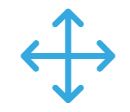Types of flex
 CHOOSING THE FLEX OF YOUR SNOWBOARD
CHOOSING THE FLEX OF YOUR SNOWBOARD
The flex of the boards varies considerably from one construction to the next. Many manufacturers give a number score from 1 to 10. 1 being the most flexible and 10 being the most rigid. Easy-gliss has standardised these flex indications. Generally, we classify flexible grades from 1-2 as soft, 3-5 as medium, 6-8 as stiff and 9-10 as very stiff. The flex feeling can vary depending on the snowboarder.
SOFT FLEX
The softer snowboards (typically freestyle) will be more forgiving and easier to steer. A soft flex is ideal for beginners, and below average weight snowboarders, but also for those suitable for the park. Soft boards tend to be a little looser at higher speeds, but can also provide a smooth feel at slower speeds.
RIGID FLEX
Rigid snowboards are usually built for freeride or off-piste use. They offer a better board hold and are more stable at high speeds. Rigid snowboards can be great for those who fix high speed turns, but difficult to steer for lightweights.
 WOMEN'S SNOWBOARD
WOMEN'S SNOWBOARD
Women's bodies and turn mechanics are not the same as men's. Since women tend to have less body mass and smaller feet than men of the same height, women's boards are narrower with thinner profiles and softer flexes.
However, the rules for choosing your board are the same for women so you can refer to the previous tips.
 CHILDREN'S SNOWBOARD
CHILDREN'S SNOWBOARD
Your child may still be growing, so it is important to find a snowboard that will suit them for a long time, but be careful not to choose a board that is too big (a board that is too big endangers the safety of your child). The right size snowboard will help your child progress faster and have much more fun. Children's snowboards are generally more flexible, to give them the best support on their first ride.
